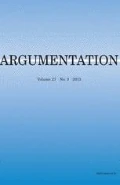Abstract
Although sophistry has been characterized as separable from real philosophy, formal analysis does not work without it and one cannot always identify just where philosophy leaves off and sophistry begins. Whether sophistry offers anything to thinking reason has to do with what parties in dialogue do with sophistries. Sophistries can close down or open up philosophical perspectives, depending on the local work that sophistic strategies accomplish. Such local work of philosophers is rarely available to analyses of docile texts, but they can be furthered by ethnomethodological studies of illustrative philosophical argumentation presented and analyzed in videotaped format.
Similar content being viewed by others
Notes
“>∼” indicates a hand-clap, a token placed at the conclusion of a formal proposition. Phrases in upper case also serve as logical tokens.
Which instances of “clear and firm” comprise exemplary philosophizing and which ones comprise sophistry?
Specifically, the Sautrāntika Svātantrika Madhyamaka.
Jetsun Chogyi Gyaltsen (1997).
Compare Socrates: “… tripping them up and turning them upside down, just as someone pulls a stool away when someone else is going to sit down” (Plato 1961, p. 392).
I am translating the term “rtsod pa phong ba” as “fling.”
’dzin tshul gcig khegs.
bden ’dzin kun brtags khegs.
It is worth noting that one could not pose this question without the analytic tools provided by digital multimedia recordings.
Yongdzin writes in his classical manual on debate, “Should a challenger make an effective refutation, the defender should not become upset but should remain undisturbed, in the way a great mountain receives the wind.”
References
Jetsun Chogyi Gyaltsen. 1997. (Se ra rJe btsun Chos kyi rgyal mtshan [1469–1546]). dBu ma’i spyi don skal bzang mgul rgyan. Bylakuppe (India): Sera Je Computer Project.
Plato. 1961. Euthedymus. In The collected dialogues of Plato, ed. Edith Hamilton, Huntington Cairns. Princeton: Princeton University Press.
Yongdzin. 1979. (Yongs ‘dzin Phur bu lcog Byams pa tshul khrims rgya mtsho [1825–1901]). Tshad ma’i gzhung don ‘byed pa’i bsdus grva’i rnam bzhag rigs lam ‘phrul gyi lde mig ces bya ba las rigs lam che ba’i skor gyi rnam par bshad pa zhugs so. Bylakuppe (India): Sera Monastic University.
Author information
Authors and Affiliations
Corresponding author
Rights and permissions
About this article
Cite this article
Liberman, K. Sophistry In and As Its Course. Argumentation 22, 59–70 (2008). https://doi.org/10.1007/s10503-007-9070-y
Received:
Accepted:
Published:
Issue Date:
DOI: https://doi.org/10.1007/s10503-007-9070-y




